Understanding Water Buoys: Importance in Surf Culture


Intro
Water buoys occupy a unique place in the world of surf culture. For surfers, these often bright, floating markers are more than just objects bobbing on the water. They represent safety and guidance, framing the boundaries between thrilling ocean rides and potential danger. In an environment where the waves can change faster than a surfer can react, understanding these devices proves invaluable.
In this exploration, we will dissect the various types of buoys you’ll encounter on the water. Think of them as unsung heroes that assist surfers in navigating their surroundings, indicating safe swimming areas or alerting them to potential dangers. Whether you're a beginner just dipping your toes in or an experienced surfer who’s carved a name in the surf scene, appreciating the significance of water buoys not only enhances your safety but also improves your performance on the waves.
So let's dive into the essentials of surfboarding techniques—starting from the basics to the advanced moves that will help you catch the perfect wave.
Surfboarding Techniques
Beginner Tips for Mastering the Basics
When you’re just starting out, getting comfortable on a surfboard and understanding your surroundings is key. It may look easy, but the truth is, it takes practice and awareness. Here are a few essential tips:
- Choose the Right Board: A larger board offers more stability and makes it easier to catch waves.
- Learn the Lay of the Land: Familiarize yourself with the area where you plan to surf. Watch for buoys indicating safe zones, rip currents, or obstacles.
- Practice Paddling: Good paddling technique leads to a higher chance of catching waves. Make sure you know how to position yourself properly for optimal balance and speed.
- Check Conditions: Always observe wind and swell conditions. Knowing how the water behaves on any given day can change your surfing experience.
These tips make the world of surfing less daunting and more navigable, which is where understanding water buoys comes in handy. For instance, knowing where the flotation devices mark the limits of a safe surfing area is crucial for beginners to avoid getting lost in a wave's midst.
Advanced Techniques for Seasoned Surfers
Once you've gained confidence and skills, pushing boundaries is part of the surf life. Advanced techniques focus not just on riding waves, but also on making quick decisions in the heat of the moment. Here are some strategies:
- Read the Waves: Advanced surfers learn to anticipate wave patterns and the behavior of water buoys that signal changes in surf. Paying attention to these cues can help you adjust your riding technique at a moment’s notice.
- Perform Tricks: As you advance, tricks like cutbacks, floaters, and aerials become part of your repertoire. Practicing these moves around buoy markers can help sharpen your spatial awareness and balance.
- Utilize Technology: Consider using surf watches or apps that give live updates on surf conditions and water safety. These tools can be crucial, especially when paired with real-time buoy information.
"Understanding your environment, including water buoy positions, can make the difference between an exhilarating ride and a risky situation."
Next, let’s branch into surfboard equipment, which enhances not just your ride but your entire surfing experience.
Prelude to Water Buoys
Water buoys play a crucial role in the oceanic landscape, particularly within the surfing community. They aren’t just colorful floats bobbing in the waves; they serve specific purposes, ranging from navigation to safety, fulfilling essential functions that enhance the surfing experience. Their significance diverges into various types, each tailored to address different needs, paving the way for safer and more informed surf sessions.
A core aspect of understanding water buoys lies in grasping their definition and purpose. Without this knowledge, surfers, instructors, and adventurers could find themselves caught off guard, unaware of the warnings or navigational aids presented by these floating markers. They can make the difference between an enjoyable day on the waves and a potentially hazardous situation.
Furthermore, the history of water buoys in surf culture reflects their evolution alongside the sport itself. From rudimentary markers signaling surfable waves to advanced buoys equipped with technology, their journey mirrors that of surfing – a blend of tradition and innovation. Understanding this history not only enriches our appreciation for these tools but also informs their present-day applications and advancements.
Overall, water buoys constitute a vital framework that interlinks safety, functionality, and the tradition of surfing. It’s essential for surfboarding enthusiasts, beginners and pros alike, to recognize the multifaceted nature of buoys, ensuring that they can effectively navigate the waves while maintaining safety.
Definition and Purpose
Water buoys can be defined as floating devices that provide critical information regarding navigation, safety, or marking various areas in the oceans and seas. They come in various shapes, sizes, and colors, each designed to convey a certain message. For instance, some buoys might indicate safe zones for surfing, while others may mark dangerous waters or provide directions for navigating through channels. Understanding the meaning behind these buoy signals is essential for every surfer and marine enthusiast.
Their primary purpose extends beyond mere decoration on the water. They serve as crucial guides for safety, helping surfers avoid perilous situations. Imagine paddling out into a surf session unacquainted with the area's hazards. Without buoys, surfers would have to rely solely on their instinct and observation, which could lead to miscalculations and dangerous encounters with riptides or underwater rocks. These floating markers provide a visible and reliable way to communicate essential information about conditions in the ocean.
"Water buoys are the unsung heroes of safety, guiding surfers where to ride the waves and where to tread carefully."
History of Water Buoys in Surf Culture
The relationship between surfing and water buoys stretches back several decades and can be traced through the evolution of both the sport and the technology that supports it. Initially, buoys were simple objects like logs or even large cans, used minimally by early surfers who relied heavily on personal experience and local knowledge.
As surfing gained traction, the need for more sophisticated alert systems became apparent. In the mid-20th century, when organized surf competitions began gaining popularity, the introduction of standardized buoy systems helped establish safer and more regulated surfing environments. These markers not only delineated competition boundaries but also served as safety measures for participants.
The arrival of innovative materials and design methods in the 21st century saw a shift from traditional buoy types to more advanced, durable, and sometimes even smart buoy systems. Today, the incorporation of GPS technology and communication systems has revolutionized how buoys function, providing up-to-the-minute data that can significantly enhance surfer safety.
Understanding the history of water buoys in surf culture provides insight into how surfers and marine officials have adapted to changes in the ocean environment and technology. The transition from basic markers to contemporary systems underscores the continuous commitment to safety and progression in surfing.
Types of Water Buoys
Understanding the various types of water buoys is crucial for surfers and mariners alike. Each buoy serves a distinct role in ensuring safety, navigation, and effective communication in aquatic environments. Knowing these types not only enhances the surfing experience but also equips users with the necessary knowledge to respect marine protocols. Each buoy is specifically designed for its intended function, and this intentionality cannot be overstated when discussing their impact on surf culture.
Marker Buoys
Marker buoys are instrumental in defining zones and pathways in the water. In the dynamic landscape of surfing, they provide essential guidance to both novices and seasoned surfers. Their identifiable colors and shapes help to communicate critical information regarding restricted areas, such as those reserved for swimming or fishing.
These buoys can often be found near surf schools or popular surf spots to delineate safe zones, ensuring that surfers can ride the waves without inadvertently drifting into perilous waters. Their visibility is key; vibrant colors, such as bright orange or yellow, catch the attention of surfers and boats alike.
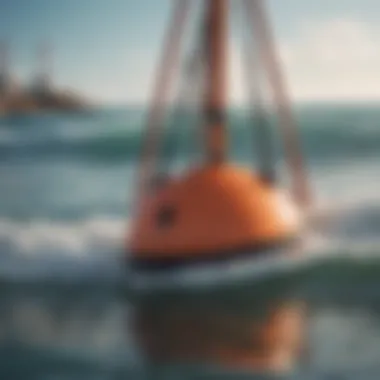
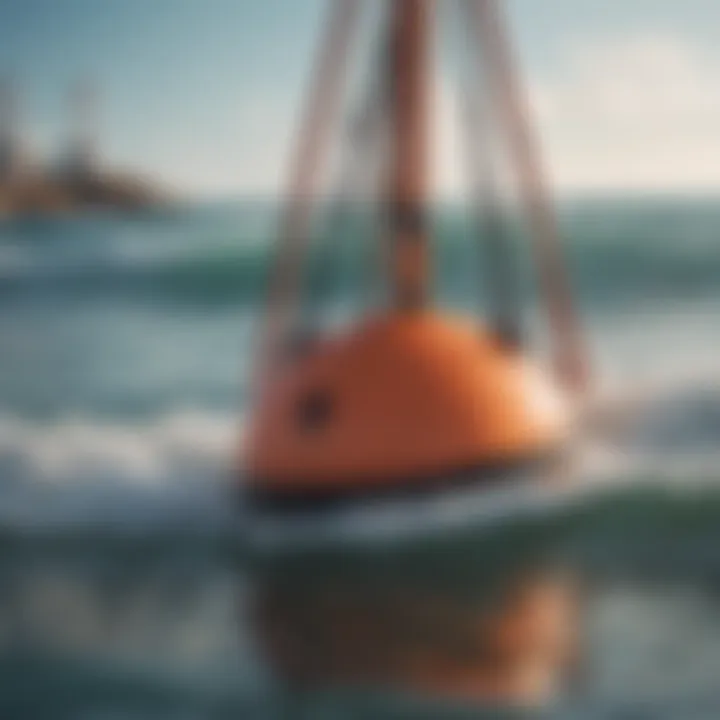
For example, during busy weekends at California beaches, marker buoys become the unsung heroes of surf safety, subtly guiding surfers away from hazards like rocks and strong currents.
Navigation Buoys
Navigation buoys serve as essential reference points in open water, particularly in areas prone to maritime traffic. They help in coordinating the movement of boats and surfers alike. These buoys often include important navigational information, such as water depth or directional markers. Knowing which way these buoys face can be a lifesaver in challenging conditions.
In surf culture, particularly in regions known for shifting tides or large swells, navigation buoys become invaluable. They offer a physical landmark that surfers can use to stay aware of their surroundings.
"For surfers, keeping an eye on navigation buoys can mean the difference between enjoying the ride and getting caught in unexpected currents."
In addition to their practical uses, navigation buoys often symbolize the intertwined relationship between surfers and the ocean—reminders that respect for maritime navigation is part of the surfing ethos.
Safety Buoys
Safety buoys play a direct role in the protection of surfers and others engaging in water activities. They are often equipped with emergency equipment, like life rings or flotation devices. These bright and highly visible buoys serve as critical points of reference during rescue operations or emergency situations.
In hosting surf competitions, safety buoys become paramount. They delineate official areas and ensure that athletes have well-marked access points to emergency assistance. Moreover, the presence of these buoys can encourage a sense of security, allowing surfers to focus on their skills rather than their safety.
On a community level, safety buoys symbolize commitment to keeping everyone safe. When surfers observe these buoys, it reinforces the understanding that not only personal safety but also the well-being of others on the water should be a priority.
In summation, the types of water buoys—marker buoys, navigation buoys, and safety buoys—all embody unique functions that are essential to integrating safety and efficiency into the water sports experience. Knowing the difference can significantly enhance a surfer’s awareness and overall enjoyment of their time on the waves.
Construction and Materials of Water Buoys
Understanding the construction and materials used in water buoys is crucial for grasping their effectiveness and safety features. The right materials not only enhance performance but also ensure longevity against the harsh marine environment. When waves are crashing and saltwater is splashing around, the last thing one wants is unreliable markers out on the ocean. Therefore, selecting the appropriate materials and engineering designs plays a significant role in their functionality.
Buoys are not just floating objects; they serve various purposes including navigation, marking safe swimming areas, and providing safety measures. A good buoy must withstand weather conditions that range from scorching sun to freezing temperatures, heavy winds to turbulent waters. This directly ties into safety, which is paramount in surf culture.
Common Materials Used
A variety of materials are employed in the construction of water buoys, each chosen for specific qualities they bring to the table. Here are some commonly used materials:
- Plastic: Lightweight and resistant to corrosion, plastics like high-density polyethylene (HDPE) are often used for their durability. Being buoyant helps them stay afloat better.
- Foam: This material is typically found in buoys meant for recreational use, providing additional flotation. Closed-cell foam, as an example, doesn’t absorb water and retains its shape.
- Metal: In some cases, particularly for navigation buoys, metals like aluminum or stainless steel are used. These offer robustness and ability to withstand more considerable forces of nature.
- Composite Materials: Many manufacturers are moving towards composites that blend different materials together, balancing weight and strength effectively.
Materials used in buoy construction not only contribute to their performance but also assist in defining how they interact with their environment. The right combination ensures that a buoy can stand tall under water stress while still being easily visible to surfers and other watercrafts.
Durability and Maintenance
When it comes to durability, the choice of materials must be paired with proper maintenance to ensure longevity. A buoy can't just float there indefinitely; they are prone to wear and tear, especially when exposed to sunny days or rough surf.
The reality is that maintenance is an ongoing concern. Keeping a close eye on environmental damage, algae growth, and degradation from UV exposure can extend the life of a buoy significantly. Some important considerations include:
- Regular inspection for signs of deterioration, cracks, or discoloration.
- Cleaning and maintaining buoy surfaces to prevent growth and buildup that may impair function and visibility.
- Checking mounting and anchoring systems to ensure stability; fixed buoys are susceptible to adverse weather.
In essence, durability intersects with maintenance in creating a reliable buoy. Given the investments made in surfing gear and water safety, understanding buoy construction ensures that you’re aligned with not just personal safety but collective responsibility within the surfing community.
"A stitch in time saves nine" is a saying that suits the diligent care of buoys. Taking proactive steps will save much hassle down the line.
By appreciating the materials and durability factors in the design of water buoys, surfers can ensure they are making informed choices in terms of safety and navigation, thus enhancing their experiences on the waves.
Technology in Water Buoys
The advancements in technology have ushered in a new era for water buoys, transforming them from simple markers to sophisticated devices that enhance safety and navigation. This evolution is crucial not only for surfers but also for a wide array of water sports enthusiasts. As we navigate through this discussion, it's vital to recognize how technology influences the design, effectiveness, and overall utility of water buoys.
Innovations in Buoy Design
The design of water buoys has come a long way since their inception. Modern buoys now incorporate state-of-the-art materials and engineering techniques that increase their visibility and durability.
- Lightweight Materials: New composite materials that are both lightweight and incredibly strong have emerged, making it easier for buoys to withstand harsh ocean conditions.
- Enhanced Visibility: Innovations like integrated LED lights ensure that buoys are visible at night or during low-visibility conditions, which is critical for safety. Think of those brightly colored buoys that stand out against the moody backdrop of gray waters.
- Smart Features: Some buoys now include smart technologies that can report their status using wireless signals. These signals can alert surfers to changing conditions or potential hazards on the water.
The importance of these innovations can't be overstated. A buoy that can signal its condition or alert users in real-time adds a layer of security that was previously absent. Such developments make waterways safer, allowing surfers and other adventurers to focus on their sport rather than the risks.
Integration with GPS and Navigation Systems
Another groundbreaking aspect of modern water buoys is their integration with GPS and navigation systems. This development profoundly impacts how surfers and navigators interact with their environments.
- Real-time Location Tracking: Buoys equipped with GPS technology allow surfers to locate them swiftly, whether for training or competition. These systems provide data that can be crucial for understanding surf patterns and tide changes.
- Safety Features: With the ability to send out distress signals or alerts, GPS-enabled buoys can significantly enhance safety for surfers. If a surfer finds themselves in a precarious situation, a buoy can relay their coordinates, guiding rescuers promptly.
- Data Collection: Some advanced buoys also collect environmental data, such as water temperature and wave height, which can contribute to more thorough understandings of marine conditions. This information is invaluable for both safety and scientific research.
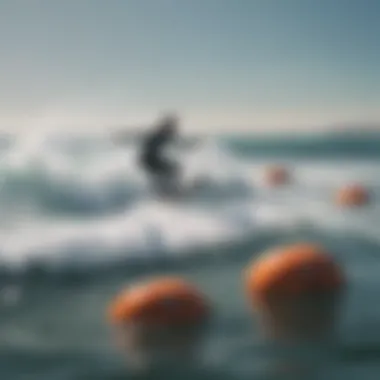
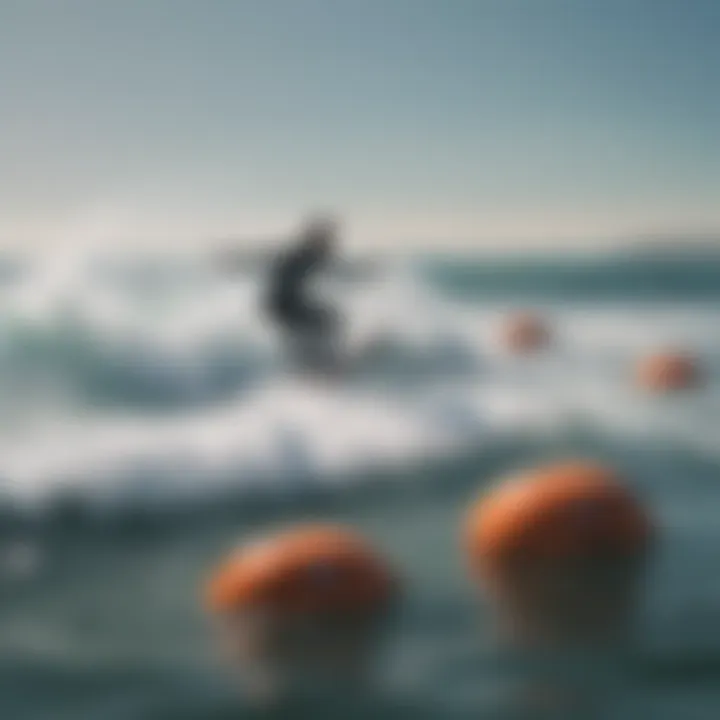
"The incorporation of GPS technology in water buoys marks a significant leap forward in our ability to maintain safety and effective navigation on the water. As surfers, we benefit directly from these tech enhancements, ensuring better experiences and protection on the waves."
In summary, technology has transformed water buoys into pivotal tools that not only elevate safety standards but also enrich the valuable experiences of surfers and adventurers alike. As these technologies continue to advance, one can only imagine how they will further enhance our interactions with the ocean and its challenges.
Environmental Considerations
In the world of surfing and water sports, water buoys are more than just floating markers. They serve as valuable tools, yet their presence prompts a deeper look into how they interact with the natural environment. Understanding the environmental considerations surrounding water buoys is crucial, especially for those who cherish the ocean and its ecosystems. This section highlights the delicate balance between functionality and eco-sensitivity, emphasizing the responsibility of surfers and manufacturers alike.
Impact on Marine Life
Water buoys can have surprising effects on marine life. In areas bustling with aquatic activity, these buoys shape the local ecosystem in various ways.
- Habitat Alteration: Some marine species adapt to the structures provided by buoys, utilizing them for shelter. For example, small fish may gather around buoys, creating micro-habitats that attract larger fish. While this can support local fishing, it also signals a change. The proliferation of these man-made structures can disrupt natural habitats, potentially leading to unforeseen consequences for native species.
- Entanglement Risks: There’s always a concern about entanglement for marine animals. The ropes and chains used to anchor buoys can pose hazards, particularly for larger species such as sea turtles and dolphins. Reports suggest that marine mammals sometimes get ensnared, leading to fatal outcomes. Therefore, designing safer buoy systems that minimize this risk is essential.
"Marine ecosystems balance on the finest strands; even a buoy can alter the course of life beneath the waves."
Surfers and those involved in marine activities should remain vigilant regarding the placement and design of buoys to ensure they do not harm marine wildlife.
Sustainable Practices in Buoy Production
The journey toward sustainable practices in buoy production can be seen as a reflection of a broader commitment to ocean conservation. Reducing environmental impact while ensuring safety and functionality is no small feat. Here are key practices that are becoming more mainstream in buoy production:
- Recycled Materials: Companies are leaning towards using recycled plastics and other materials to manufacture buoys. This shift helps reduce the demand for virgin resources and can significantly lower the carbon footprint associated with production.
- Biodegradable Options: Innovative designs are emerging that incorporate biodegradable materials for certain buoy components. Using these materials means less long-term waste, easing pressure on marine environments.
- Durability Enhancements: Building buoys that last longer means fewer replacements, which is not only cost-effective but also environmentally friendly. Higher durability leads to less waste and fewer resources spent on manufacturing replacements.
- Eco-Friendly Coatings: The introduction of non-toxic coatings can significantly reduce the risk of chemical leaching into the ocean. Many buoys are now treated with finishes that are safe for marine life and do not contribute to water pollution.
By adopting these sustainable practices, the industry can help ensure that water buoys do their job without compromising the health of our oceans and the myriad of life they support.
As surfers, instructors, and adventurers take to the waves, their awareness and support for environmentally friendly practices make a difference, transitioning from traditional buoy designs to more sustainable alternatives.
Regulatory Standards for Water Buoys
When it comes to ensuring the safety and functionality of water buoys, regulatory standards play a critical role. These standards provide a framework that guides the design, placement, and use of buoys in various aquatic environments. For surfers and water sports enthusiasts, understanding these regulations can make the difference between a safe, effective navigation system and an accident waiting to unfold.
Water buoys serve multiple purposes, from marking hazards to guiding navigation or providing safety. Without clear regulatory standards, there's a potential for confusion and misuse. Regulations not only aim to maintain uniformity across different regions but also protect marine life and promote environmental sustainability. They help ensure that buoys can withstand the stresses of nature while remaining visible and functional for users.
National and International Guidelines
Regulatory standards can vary significantly on a national and international level. In the United States, the U.S. Coast Guard outlines specific guidelines for the usage of navigational buoys, including their colors, shapes, and illumination requirements, which are crucial for safe navigation. For instance, red buoys typically indicate safe passage on the starboard (right) side, while green buoys mark the port (left) side. This color-coded system streamlines navigation and enhances safety for all watercraft operators.
On the international stage, organizations such as the International Association of Lighthouse Authorities and the International Maritime Organization have developed standards that harmonize buoy regulations across countries. This is particularly important for areas that might see a mix of international surfing events or cargo shipping. The adoption of these standardized protocols minimizes risks for both local surfers and international mariners.
- Color Codes: Different colors signify different meanings (red for right, green for left, etc.).
- Shape and Size: There are guidelines for the shape and size of buoys to ensure visibility and recognition at various distances.
- Reflectivity: Nighttime visibility is crucial; reflective surfaces or lights may be mandated.
Compliance and Safety Measures
Adhering to these regulations is of utmost importance. Compliance with buoy standards not only supports safety but also ensures that any surfing competition follows the designated regulations necessary for an event. For example, during a surfing championship, having the correctly placed safety buoys can mitigate risks related to surf conditions and help rescuers reach surfers in distress faster.
Moreover, safety measures often include regular inspections and maintenance schedules to ascertain the buoy's condition and ensure compliance with regulatory standards. Such practices are essential to tackle issues like vandalism or natural wear and tear, which can compromise their effectiveness.
"The safety of surfers is deeply intertwined with the regulations that govern water buoys. Compliance isn’t just an option; it’s a necessity for the community."
These regulatory measures encompass various practices, such as:
- Inspection Protocols: Regular checks to monitor the physical state and positioning of buoys.
- Installation Guidelines: Specifications regarding how and where buoys should be anchored or positioned to prevent accidents.
- Environmental Assessments: Evaluations of the ecological implications of buoy placement to mitigate negative impacts on marine ecosystems.
Understanding and respecting the regulatory framework surrounding water buoys empowers surfers and water sports practitioners to navigate the waters safely, contributing to a harmonious relationship between human activity and marine environments.
The Role of Water Buoys in Surfing
Water buoys play a crucial role in establishing the fascinating dance between surfers and the unpredictable ocean. Their presence not only serves practical purposes but also enhances the experience for all those who dare to ride the waves. When we think of a day spent surfing, buoys silently uphold a structure that is often taken for granted.
Enhancing Safety for Surfers
Safety is the name of the game in any sport, and surfing is no exception. Water buoys offer indispensable markers that help signify safe areas for surfers, especially in crowded beaches or spots known for powerful waves. These buoys are often positioned strategically to delineate zones where surfers can ride and areas where larger vessels may navigate. Without them, chaos could ensue, with surfers in danger of colliding with boats or other surfers.
Moreover, many buoys are brightly colored or bear distinctive designs, making them easily identifiable from afar. This visibility becomes particularly important in rough conditions where natural landmarks may be obscured.
"Buoys not only guide surfers but also safeguard them, ensuring they enjoy the thrill of the waves without unnecessary risks."
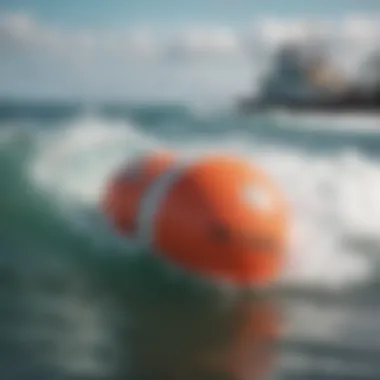
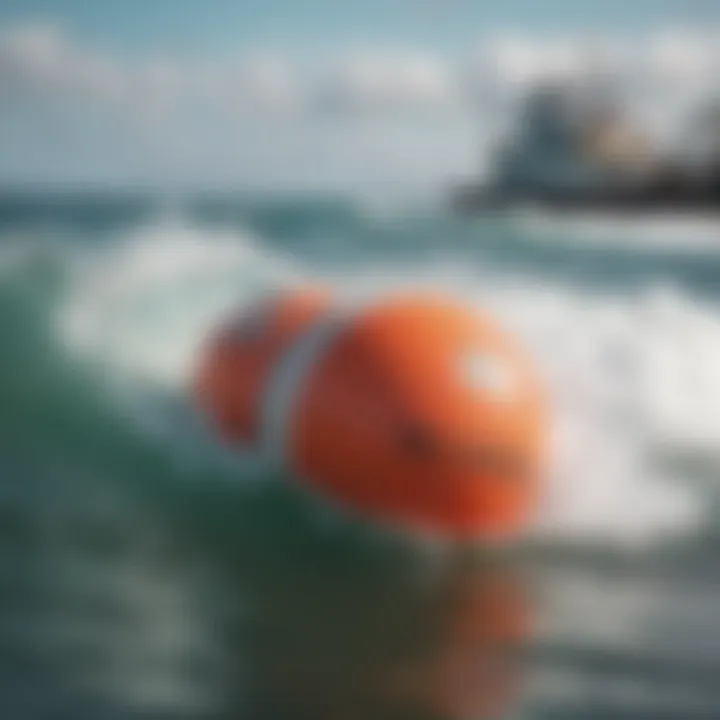
Another aspect of safety involves placing safety buoys near more perilous surfing spots. These indicate rip currents or shallow reefs, offering visual cues that can prevent accidents. Even experienced surfers can benefit significantly from the presence of these materials, as the ocean can shift unexpectedly.
Guiding Surfing Competitions
When it comes to organized competitions, the role of water buoys takes on an entire new dimension. They help delineate the competition area, ensuring all contestants are aware of the boundaries. In various competitions, buoys serve as turning points, requiring surfers to navigate around them as part of the race. This adds another level of challenge and excitement, melding strategy with skill.
When competitors are practicing or waiting for their heats, buoys also help to maintain clarity in the water, providing visual markers that can help them position themselves for optimal waves. In today’s surf competitions, accurate navigation through water is often what separates the winners from the rest, showcasing just how vital buoys are in the sport.
Challenges and Limitations of Water Buoys
Water buoys, while serving critical functions in marine environments, face their share of challenges and limitations. Understanding these issues is vital not just for manufacturers or regulatory bodies, but also for the surfers and enthusiasts reliant on these floating markers for guidance and safety.
Weather and Water Conditions
Weather plays a significant role in the effectiveness of water buoys. High winds and turbulent waves can easily topple or displace them, making it difficult for surfers to spot the critical markers they rely on for navigation and safety. For instance, during a stormy season, buoys can become submerged or drift away from their intended positions. This unpredictability can lead to dangerous situations, especially for novice surfers who depend on these visual aids to avoid hazardous areas.
Moreover, varying water conditions can also degrade the materials used in buoy construction. Regular exposure to salty water, UV rays from the sun, and extreme temperatures can cause wear and tear, impairing the buoy’s functionality. Without regular maintenance and monitoring, a seemingly sturdy buoy might become a liability rather than an asset, which can compromise safety in water sports.
"A buoy out of place is like a compass that points south when you need north."
To combat these issues, it's essential that local authorities engage in regular inspections and adopt a proactive maintenance schedule. By doing so, they can ensure that buoys remain in place and functional, especially in unpredictable weather patterns. Additionally, incorporating more durable materials and designs that can withstand harsh marine environments can enhance the longevity of these devices.
Vandalism and Damage
Another pressing concern for water buoys is the threat of vandalism. Unfortunately, surf culture isn't immune to acts of mischief. Some individuals may see buoys as targets for pranks or personal expression, defacing them or even removing them altogether. Such actions can have dire consequences, as damaged or missing buoys pose significant hazards to surfers who rely on them for navigation and safety.
Moreover, poorly placed or dismantled buoys can lead to confusion among surfers, resulting in dangerous situations, particularly in competitive settings. For instance, during a surf competition, a missing buoy could misguide competitors, altering their expected paths and possibly leading to accidents.
To mitigate these issues, communities can do a few things:
- Increase Awareness: Educate the community on the importance of buoys for safety in water sports.
- Establish Reporting Mechanisms: Make it easy for surfers and beachgoers to report damaged or missing buoys quickly.
- Engage Local Boards: Involve surf associations or community boards in monitoring the state of buoys.
Overall, while buoys play an essential role in ensuring safety, they are vulnerable to factors beyond their control. As the surf culture grows, awareness and accountability surrounding these nautical markers must also deepen, so everyone can enjoy the waves without unnecessary risks.
Future Outlook for Water Buoys
The future of water buoys is not just a matter of floating objects in water; it embodies the journey of safety and innovation in aquatic sports, particularly surfing. As technology advances, the segment of water buoys is poised for substantial transformation. Understanding these changes is crucial for surfers, instructors, and eco-enthusiasts alike, who depend on reliable systems for safety and navigation while enjoying their time on the waves.
Advancements in Technology
Technology continues to shift the paradigm when it comes to water buoys. From basic floating markers to sophisticated GPS-enabled devices, the evolution is remarkable.
Smart Buoys: One of the pressing developments is the advent of smart buoys. These devices incorporate sensors that can provide real-time data on water conditions, wave heights, and even water temperature. This kind of information thickens the plot—surf instructors, for example, can use this data to enhance their teaching by selecting the best time for lessons based on current environmental conditions.
Solar-Powered Buoys: Another significant advancement is the use of sustainable energy sources. With solar-powered buoys, there's less reliance on batteries and other fossil fuel-based energy. This shift diminishes the environmental footprint these devices leave behind. Imagine a buoy gently bobbing in the water, gathering sunlight to power its sensors and lights. It’s an innovation that saves resources while keeping users informed.
Telecommunication Links: Communication technologies are also advancing, turning buoys into beacons that can transmit information to surfers directly via apps. This will enable real-time alerts on safety issues, weather changes, and even rules for surfing spots.
Predicted Trends in Usage
As technology continues to innovate, it's essential to recognize how the trends in buoy usage are likely to unfold.
"Water buoys are essential in contributing to the safety and enjoyment of water sports. Their role is irreplaceable as we advance into the future."
Increased Use in Racing Events: Expect more buoys to fill competitive wave-riding arenas across the globe. Enhanced functionalities will ensure that they are aligned with competition standards, clearly marking courses while providing data to organization teams. Surfers will have an easier time understanding the parameters of their sport, leading to better performance and safer experiences.
Adoption by Recreational Surfers: The general surfer population might not be far behind in harnessing buoy technology for personal use. Enhanced navigation systems tailored for casual surfers could hit the markets. With the ease of an app, surfers will navigate through local surf breaks, ensuring they find the best waves while staying cognizant of their safety.
Environmental Monitoring: Lastly, water buoys won't only serve the surfing community; they can play a vital role in environmental monitoring as well. By collecting data related to water quality, temperature, and marine biodiversity, they offer insights that are invaluable for conservation efforts. Environmental agencies are likely to utilize this data for better management of local ecosystems and for educating the public.
As we look down the pipeline, the evolution of water buoys signals an exciting chapter for surfing and water sports as a whole. Engaging with these innovations can not only enhance the experience but can also foster a culture of safety and environmental mindfulness among all who share the ocean.
Closure
Water buoys are more than just bright markers bobbing in the surf; they are essential tools that enhance safety and navigation while engaging with the ocean. This article has sought to peel back the layers surrounding water buoys, illuminating their pivotal role in surf culture. By diving into their types, materials, technological advancements, and environmental considerations, we've presented a full picture to help surfers appreciate what lies behind these floating sentinels.
Summary of Key Points
- Types of Water Buoys: Various models serve unique functions — from marker buoys indicating locations to safety buoys that act as life-saving devices.
- Construction: Understanding the materials used in buoy design is crucial; many buoys are crafted from durable, lightweight substances that withstand harsh marine environments.
- Technology Integration: Modern buoys are not just passive markers; they're integrated with GPS and advanced systems to provide real-time data to surfers and mariners alike.
- Environmental Considerations: There’s a growing focus on sustainability in buoy production, ensuring that while they serve human needs, they do not negatively impact marine ecosystems.
- Regulatory Standards: Knowledge of both national and international guidelines assures users that safety measures are taken seriously, promoting responsible use.
Final Thoughts on Water Buoys
In wrapping up this exploration, it’s clear that water buoys hold a multifaceted significance in the surfing community. They not only safeguard surfers but also provide essential information that enhances the overall experience on the water. As technology keeps evolving, the future holds promise for smarter, more environmentally-conscious buoys. For surfers, instructors, and anyone drawn to the waves, an understanding of these floating markers can greatly improve safety and performance in unpredictable ocean settings. So next time you hit the surf, take a moment to appreciate the buoy that helps you ride the waves just a bit safer.















